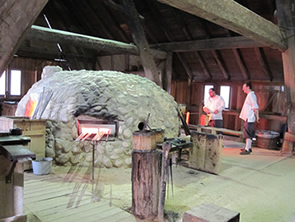
Courtesy of Rob Bole, Flickr's Creative Commons
The park interprets the story of early America in two locations: Old Towne is the site of the initial years of the colony within the fort that that the English built in 1607, and New Towne documents the expansion of the city from the 1620s until 1699. A visitor center or museum at each site tells the story of this early settlement through interpretation and artifacts. Today, visitors can explore the history of Jamestown, from its earliest beginnings as a campsite for American Indians to the later English settlement period.
The English were not the first settlers on Jamestown Island. More than 30 Powhatan Indian tribes had lived in the area for thousands of years and sustained the lush landscape. In 1607, John Smith sailed to North America with a crew of entrepreneurs. They chose Jamestown Island because it provided a secure, deep-water harbor that would be beneficial for trading. To keep their settlement unknown to Spanish explorers and to protect themselves from Algonquin Indian attacks, John Smith and the settlers moved inland and constructed a fort. Today, the site of this fort is called "Old Towne,” and within the reconstructed fort walls, visitors can see artifacts from the life of these early adventurers, as well as learn how English settlers negotiated with and relied on Powhatan Indians. One of John Smith’s most important contacts was the Chief of the Powhatan people and his daughter, Pocahontas. Her relationship with the English settlers was complicated and has been the subject of much debate; to read more about her life click here. The Jamestown Rediscovery Project found more than ninety percent of the 1607 fort on land, excavating and studying structures, wells and burials, and collecting over a million and a half artifacts. Visitors can see some of the most interesting artifacts at the site.
In 1609, John Rolfe sailed from England to the settlement in Virginia. Under the direction of the Virginia Company, he and other settlers began industrial pursuits they hoped would bring profits to the company, such as manufacturing silk, glass, lumber, sassafras, pitch and tar, and soap ashes. Rolfe was the first to plant tobacco seeds in Virginia, and under his leadership, the export of tobacco grew dramatically.
Glassmaking was another of the first industrial activities in Virginia intended to bring financial stability to the new settlers. With an abundance of raw materials and the expertise of Dutchmen, Poles, and Italians, the artisans produced glass items in their original glasshouse. Unfortunately, for the settlers, this industry never boomed. The original glasshouse was rediscovered in 1948. Today, visitors can watch skilled glassblowers create wine bottles, pitchers, and a variety of other glass items at the reconstructed Jamestown Glasshouse, where the glass creations are for sale.
In the 1620s, William Claiborne began surveying land east of the fort, and this area developed and prospered as New Towne until the colonial capital moved to Williamsburg in 1699. During these years, this official government port city bustled with prominent officials and merchants, as people traveled there to attend the courts; serve on the House of Burgesses; or have their tobacco graded, weighed, and taxed. Prominent officials and merchants built grand residences; and taverns, warehouses, and wharves served Jamestown’s visitors.
At New Towne, visitors can explore the large, complex settlement that was the site of the English experiment in colonization at Jamestown. In the mid-1620s, streets and brick homes appeared in New Towne. One street in particular, the Backstreet, was the site of the homes of prominent Virginians. Well into the 1700s, the Backstreet remained a fashionable address. The archeological remains of Richard Ambler’s mansion and the Chiles family home are a feature on the tour route of New Towne.
Archaeologists continue to uncover objects, such as a clay oven, a gun shop, a jail, and warehouses, which give insight into the colonists’ experience on the island. A gunsmith suggests the importance of gun ownership to colonists who used firearms for protection, while warehouses are evidence of expanding trade and the need for more storage space for increasing imports. The Greate Road also reveals the colony’s connection to other settlements for trade purposes. Visitors can walk, bike, or drive the Island Loop Drive through New Towne, which highlights the variety of the settlers’ industrial endeavors. This three or five-mile loop also gives visitors fabulous views of the James River, the regenerating forest, and marshlands.
In addition to Jamestown, visitors can explore Virginia’s Historic Triangle of Yorktown, Jamestown, and Williamsburg and learn more about the war, peace, feast, and famine that shaped the early history of this country. More information on Yorktown and Williamsburg is available in the description of Colonial National Historical Park in this itinerary. Explore the beginnings of the English colonists’ attempts at self-sufficiency at Jamestown, walk though the recreated colonial fort, see the remains of town buildings, learn more about early industry and community leaders, and, above all, learn how America grew from a small island on the James River.
Jamestown National Historic Site, a unit of the National Park System, is located at 1368 Colonial Parkway in Jamestown, VA. Click here for National Register of Historic Places registration file: text and photos. A fee is charged to visit the park; a combination pass for other nearby parks is available. The park is open 8:30am to 4:30pm daily, except on Thanksgiving, Christmas, and New Year’s Day. The glasshouse and visitor center maintain separate hours. For more information, visit the National Park Service Jamestown National Historic Site website or call 757-856-1200. Jamestown is part of Colonial National Historic Park, which is also featured in this travel itinerary.
Historic Jamestown offers a variety of guided tours with rangers, preservation archeologists, and costumed interpreters.
Many of the architectural remains within Jamestown have been documented by the National Park Service’s Historic American Buildings Survey.
Last updated: August 11, 2017
